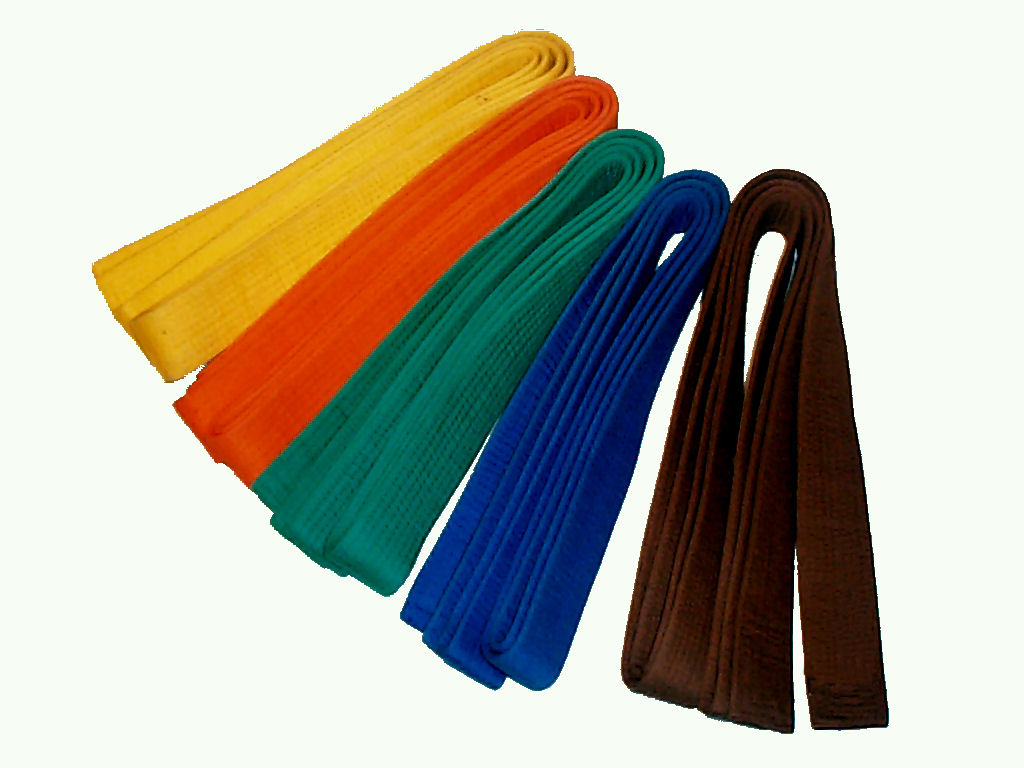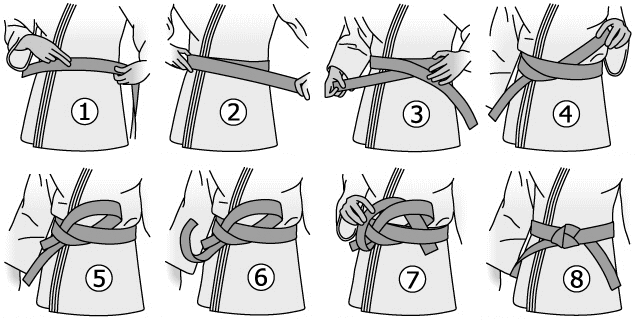Karate Belt on:
[Wikipedia]
[Google]
[Amazon]


 Many
Many


 Many
Many Japanese martial arts
Japanese martial arts refers to the variety of martial arts native to the country of Japan. At least three Japanese terms (''budō'', ''bujutsu'', and ''bugei'') are used interchangeably with the English phrase Japanese martial arts.
The usage ...
feature an as part of their exercise outfit. Such an ''obi'' is often made of thick cotton and is about 5 cm wide. The martial arts ''obi'' are most often worn in the ''koma-musubi'' knot ( square knot); in practice where a '' hakama'' is worn, the ''obi'' is tied in other ways.
In many martial arts, the colour of the obi signifies the wearer's skill level. Usually the colours start from white for beginners and end in black or red-and-white for masters.
Aikido
Unlike in many other martial arts, adult practitioners of aikido do not traditionally wear coloured obis,Bennett p. 8-11 though in some schools different colour codes have been formed, especially for children. The children's obis range from white for beginner level to 7th kyū, other colours for the rest of the kyū levels, and black for levels 1st dan and up.Goodman s. 70 In some aikido schools, wearing a hakama is a privilege earned by reaching the firstdan
Dan or DAN may refer to:
People
* Dan (name), including a list of people with the name
** Dan (king), several kings of Denmark
* Dan people, an ethnic group located in West Africa
**Dan language, a Mande language spoken primarily in Côte d'Ivoir ...
level. In other schools, all practitioners may wear a ''hakama''. After taking up using a hakama, the colour of obi does not matter since it will be covered by the hakama.
Example of colour range in aikido
Below is a typical example of obi colours per level in aikido: However, aikido schools worldwide may use their own systems with little reference to other schools save the use of a black belt for at least some dan grades.Bujinkan Budō Taijutsu
The makes use of only a limited set of belt colours, however there are also different associated uniform emblems or , the style of which varies dependent on the grade of the Budoka. Unlike many other martial arts, the number of Dan grades extends to ''Jūgodan'' (15th Dan), and practitioners at this grade of may also be gifted the status of by the ''Sōke'' This title also comes with its own ''wappen'' style featuring a purple background.Ninjutsu
Ninja obi are required within JNF and WNF.Atarashii naginata
The outfit used for Atarashii naginata practice includes a hakama that covers the obi. The obi is always white; its colour has no significance beyond simply blending in with the white keikogi worn when practicing the art.Iaido
The outfit worn to iaido practise includes a hakama, which is worn over the top of the obi, which fastens the keikogi. The obi colour has no meaning in iaido, and is usually chosen to blend in with the kimono or hakama worn by the practitioner.Jōdō
The outfit used forjōdō
, meaning "the way of the ''jō''", or is a Japanese martial art using a short staff called ''jō''. The art is similar to ''bōjutsu'', and is strongly focused upon defense against the Japanese sword. The ''jō'' is a short staff, usually a ...
practise includes a hakama that covers the obi. The colour of the obi has no significance.
Judo
Below are the colours of obis worn for judo practise. Junior practitioners have a different colour range. There are also other colour ranges used worldwide.Ju-Jitsu
The colours for obis used for Ju-Jitsu practise range as follows: Different Ju-Jitsu federations use different colours. An alternative is shown below.Jūkendō
The outfit used forJūkendō
is the Japanese martial art of bayonet fighting,Stevens, J. (1985): "The Founder, Ueshiba Morihei." In R. Strozzi-Heckler (Ed.): ''Aikido and the new warrior'' (pp. 5–22). Berkeley, CA: North Atlantic. ()Mather, J. (1990): "A Sensei's story: K ...
practise includes a hakama that covers the obi. The colour of the obi has no significance.
Karate
Kyokushin
For adults, an obi worn in Kyokushin karate signifies rank as follows: Stripes on non-black obis can be either black or the next obi's color. Some brown obis sport white stripes. On a black obi, gold is the most seen stripe color. Note that some dojo's in Kyokushin use a more elaborate striping system for children, allowing for a higher frequency of exams. Some higher degree blackbelts prefer to wear a plain black obi, with no markings.Wadō-ryū
The obis used in the wadō-ryū style range in colour as follows:Shotokan
The obis used in the shotokan KUGB style range in colour as follows:Shitō-ryū
The obis used in theShitō-ryū
is a form of karate that was founded in 1934 by . Shitō-ryū is synthesis of the Okinawan Shuri-te and Naha-te schools of karate and today is considered one of the four main styles of the art.
History
Kenwa Mabuni (Mabuni Kenwa 摩文仁 ...
style range in colour as follows:
Kendo
The outfit used forkendo
is a modern Japanese martial art, descended from kenjutsu (one of the old Japanese martial arts, swordsmanship), that uses bamboo swords (shinai) as well as protective armor (bōgu). Today, it is widely practiced within Japan and has spread ...
practise includes a hakama that covers the kendogi. An obi is optional; if worn, its colour has no significance.Goodman s. 214. This was mentioned in Sword Art Online when Kirito and his sister fought using Kendo.
Kyūdō
The outfit used for kyūdō practise includes a hakama that covers the obi. The colour of the obi has no significance.T'ai Chi Ch'uan
The outfit used for T'ai Chi is either loose-fitting, comfortable clothing or the same kind of uniform as other Chinese martial arts. Some schools also include a coloured sash, but no standard for their order has been established.See also
* Cummerbund belt *Kung Fu (Ranking)
Chinese martial arts, often called by the umbrella terms kung fu (; ), kuoshu () or wushu (), are multiple fighting styles that have developed over the centuries in Greater China. These fighting styles are often classified according to commo ...
References
* *Notes